
SPIRO MOUNDS
PREHISTORIC GATEWAY ...
PRESENT-DAY ENIGMA
Text by Don G. Wyckoff
and Dennis Peterson
A traveling exhibition presented by the Stovall Museumof Science and History and the Oklahoma Archaeological Survey.

Spiro Mounds: Prehistoric gateway ... Present-day enigma

The Mound builders of North America circa A.D. 900-1500
Spiro Mounds
Prehistoric gateway ... Present-day enigma
The mounds at Spiro, Oklahoma, are among themost important archaeological remains in theUnited States. A remarkable assemblage of artifactsfrom the mounds shows that prehistoric Spiropeople created a sophisticated culture which influencedthe entire Southeast. There was an extensivetrade network, a highly developed religiouscenter, and a political system which controlled theregion. Located on a bend of the Arkansas River,the site was a natural gateway between societies tothe east and the west, a gateway at which Spiropeople exerted their influence. Yet much of theSpiro culture is still a mystery, including the reasonsfor the decline and abandonment of the site.Their objects remain intriguing, and pique the creativethoughts of professional and layman alike.Today, the Spiro site and artifacts are among Oklahoma’srichest cultural resources, and the site isOklahoma’s only National Historic Landmark andarchaeological park.
This archaeological site includes the remains ofa village and eleven earthen mounds. Althoughvarious groups of people had camped on or near theSpiro area since early prehistoric times, the locationdid not become a permanent settlement untilapproximately A.D. 600. Spiro Mounds was renownedin southeastern North America betweenA.D. 900 and circa 1400, when Spiro’s inhabitantsdeveloped political, religious and economic institutionswith far-reaching influence on societiesfrom the Plains and the Mississippi Valley to muchof what is now the southeastern United States.Because Spiroans maintained such practices asmound construction, a leadership of priest-chiefs,horticulture (of corn, beans and squash), and areligious tradition (the “Southern Cult”) commonto the Southeast, they were an example of whatarchaeologists have termed the Mississippian culturaldevelopment in America.
Spiro was known locally as a prehistoric Indiansite as early as the late nineteenth century.However, it was not until 1933 that the SpiroMounds attracted national and worldwide attention.In that year, a group of treasure huntersleased the site and began excavating the largestmound. They discovered rich troves of spectacularartifacts, including objects of wood, cloth, copper,shell, basketry and stone. Unfortunately, the diggerswere only concerned with finding and sellingthe relics, not with preserving or recording theirsignificance or their context. Consequently, notonly were important prehistoric artifacts lootedand sold out of Oklahoma, but, like pages rippedfrom a rare book, irreplaceable informatio